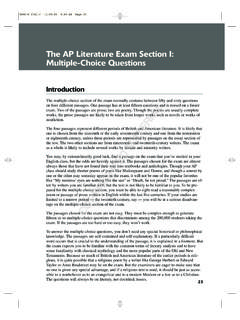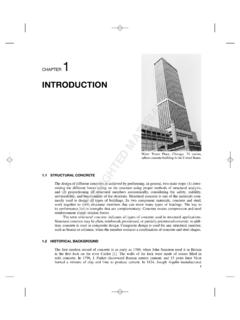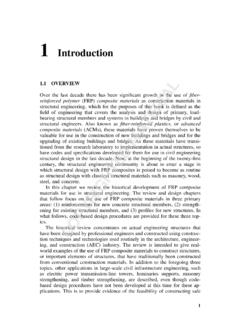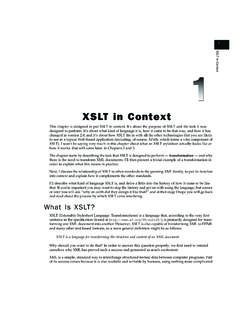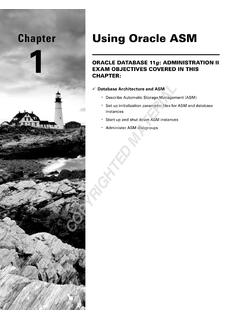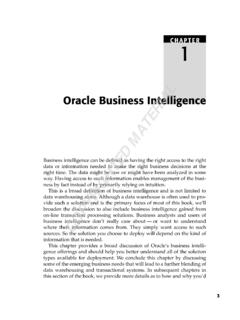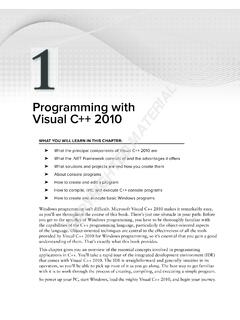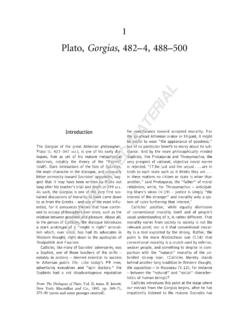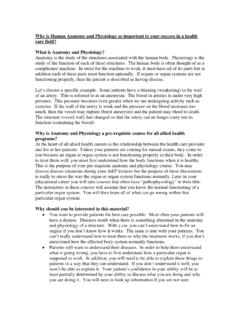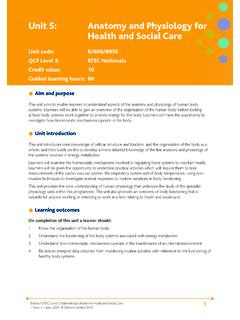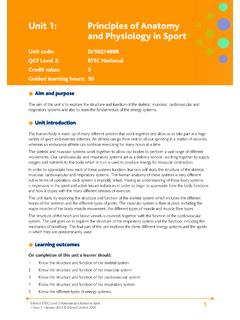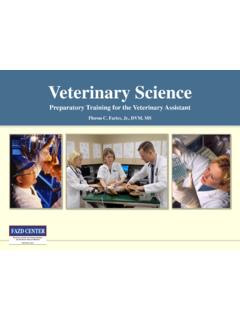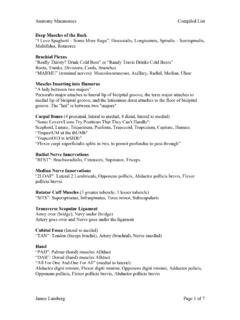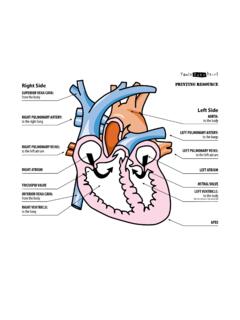Transcription of ANATOMY AND PHYSIOLOGY OF Farm Animals …
1 ANATOMY AND PHYSIOLOGY OFFarm AnimalsSEVENTH EDITIONCOPYRIGHTED MATERIALINTRODUCTION TO ANATOMY AND PHYSIOLOGYThe term ANATOMY has come to refer to the science that deals with the form and struc-ture of all organisms. Literally, the word means to cut apart; it was used by early anatomists when speaking of complete dissection of a contrast to ANATOMY , which deals primar-ily with structure, PHYSIOLOGY is the study of the integrated functions of the body and the func-tions of all its parts (systems, organs, tissues, cells, and cell components), including biophys-ical and biochemical ANATOMY and PHYSIOLOGY courses are taught separately, the approach to the laboratory portion of each course is considerably different. Study in a typical gross ANATOMY laboratory is based primarily on dissection of animal cadav-ers. These usually have been preserved by embalming, and one or more parts of the vas-cular system have been injected with a colored material to facilitate identifi cation of the vessels.
2 Careful dissection coupled with close observa-tion gives the student a concept of the shape, texture, location, and relations of structures visible to the unaided eye that can be gained in no other way. Similarly, the use of the micro-scope with properly prepared tissue sections on slides is essential for understanding structures that are so small they cannot be seen without optical or electron microscopic the PHYSIOLOGY laboratory, the student studies the response of whole Animals , isolated Descriptive Terms Useful in the Study of AnatomyMicroscopic ANATOMY : animal Cells and TissuesEpithelial TissuesConnective TissuesMuscle TissueNervous TissueThe General Plan of the animal BodyChapter 1 34 / ANATOMY AND PHYSIOLOGY OF farm Animals organs, or individual cells to changes in their environment (both internal and external).Changes may be induced by almost any agent or manipulation, for example, drugs, changes in temperature or altitude, surgical modifi cations (such as neutering), and changes in diet.
3 Monitoring of the responses may be as simple as monitoring changes in body weight or as complex as measuring the electrical poten-tial across the cell membrane of a single and physiologists working in research use some of the same techniques that are used in teaching laboratories but with con-siderable refi nement. Both types of scientists use equipment and methods developed in the physical sciences, particularly chemistry and physics. The anatomist applies the principles of physics to the use of microscopes and applies knowledge of chemistry in the staining of various parts of cells and tissues. The combina-tion of chemistry and microscopic ANATOMY is known as ANATOMY and PHYSIOLOGY are com-monly pursued as more or less independent disciplines, they are both facets of the study of the animal body. A thorough knowledge of structure imparts much information about its function. However, a mere description of struc-ture without describing function would be of little practical value.
4 Conversely, it is impossible to gain a thorough understanding of function without a basic knowledge of science of ANATOMY has become so extensive that it is now divided into many spe-cialized branches. In fact, Dorland s Medical Dic-tionary defi nes 30 subdivisions of ANATOMY . This text chiefl y describes gross (macroscopic) ANATOMY . This is the study of the form and relations (relative positions) of the structures of the body that can be seen with the unaided eye. Comparative ANATOMY is a study of the structures of various species of Animals , with particular emphasis on those characteristics that aid in classifi cation. Embryology is the study of developmental ANATOMY , covering the period from conception (fertilization of the egg) to birth. Another large branch of ANATOMY consists of the study of tissues and cells that can be seen only with the aid of a microscope. This is known as microscopic ANATOMY , or most recent development in the study of ANATOMY is ultrastructural cytology, which deals with portions of cells and tissues as they are visualized with the aid of the electron microscope.
5 The term fi ne structure is used fre-quently in reference to structures seen in elec-tron micrographs (photographs made with the electron microscope).Our approach to the study of ANATOMY will be chiefl y by systems systematic ANATOMY . To name the study, the suffi x -ology, which means branch of knowledge or science, is added to the root word referring to the system. Table 1-1 Table 1-1. Nomenclature for Systematic AnatomySystemName of StudyChief StructuresSkeletal systemOsteologyBonesArticular systemArthrologyJointsMuscular systemMyologyMusclesDigestive systemSplanchnologyStomach and intestinesRespiratory systemSplanchnologyLungs and airwaysUrinary systemSplanchnologyKidneys and urinary bladderReproductive systemSplanchnologyOvaries and testesEndocrine systemEndocrinologyDuctless glandsNervous systemNeurologyBrain, spinal cord, and nervesCirculatory systemCardiologyHeart and vesselsSensory systemEsthesiologyEye and ear INTRODUCTION TO ANATOMY AND PHYSIOLOGY / 5indicates the commonly accepted systems, the name of the study of those systems, and the chief structures involved in each has also become so extensive in scope that many areas of specialization are recognized.
6 Like ANATOMY , these may be based on body systems ( , neurophysiology, gas-trointestinal PHYSIOLOGY , cardiovascular phy-siology, respiratory PHYSIOLOGY , endocrine PHYSIOLOGY , and reproductive PHYSIOLOGY ) or the level of biological organization (cell physi-ology and organismal PHYSIOLOGY ). All of these subdivisions become the parts of such overall areas of study as applied PHYSIOLOGY , compara-tive PHYSIOLOGY , pathophysiology, medical PHYSIOLOGY , and mammalian PHYSIOLOGY . We will be concerned with these systems and studies as they relate specifi cally to farm Terms Useful in the Study of AnatomyWhen giving geographic locations, we make use of certain arbitrary frames of reference known as meridians of latitude and longitude. However, since an animal is rarely oriented exactly with a line on the earth s surface, our frames of reference must be in relation to the animal itself and must apply regardless of the position or direction of the animal (Fig.)
7 1-1). Many terms of direction differ signifi -cantly between human and domestic animal ANATOMY because of the orientation of bipedal versus quadrupedal stance. Although use of human anatomical nomenclature in quadru-peds usually leads to confusion, the terms anterior, posterior, superior, and inferior are frequently used to describe the eye and aspects of dental ANATOMY of both human RostralCranialDorsalCaudalDistalProximal PlantarCaudalCranialDorsalVentralPalmarC audalCranialDorsalMedialLateralTransvers e PlanesMedianPlaneSagittalPlaneFrontalPla neFigure 1-1. Directional terms and planes of the animal / ANATOMY AND PHYSIOLOGY OF farm Animals beings and domestic Animals (see Chapters 11 and 12).Cranial is a directional term meaning toward the head. The shoulder is cranial to the hip; it is closer to the head than is the means toward the tail. The rump is caudal to the and caudal are directional terms used in reference to features of the head to mean toward the nose (rostral) or toward the tail (caudal).
8 The median plane is an imaginary plane passing through the body so as to divide the body into equal right and left halves. A beef carcass is split into two halves on the median sagittal plane is any plane parallel to the median plane. The median plane is sometimes called the midsagittal transverse plane is at right angles to the median plane and divides the body into cranial and caudal segments. A cross-section of the body would be made on a transverse plane. The cinch of a saddle defi nes a transverse plane through the thorax of a horizontal plane is at right angles to both the median plane and transverse planes. The horizontal plane divides the body into dorsal (upper) and ventral (lower) segments. If a cow walks into a lake until the water comes above the chest, the surface of the water is in a hori-zontal plane in relation to the addition to the planes of reference, other descriptive terms are valuable in defi ning an area we wish to is an adjective meaning close to or toward the median plane.
9 The heart is medial to the lungs; it is closer to the median plane than are the lungs. The chestnut is on the medial aspect (inside) of a horse s limb; it is on the side closest to the median is the antonym of medial; it means away from the median plane. The ribs are lateral to the lungs, that is, farther from the median means toward or beyond the back-bone or vertebral column. The kidneys are dorsal to the intestines; they are closer to the vertebral column. Dorsum is the noun referring to the dorsal portion or back. A saddle is placed on the dorsum of a means away from the vertebral column or toward the midabdominal wall. The udder is the most ventral part of the body of a cow, the part of the body farthest from the vertebral and internal indicate proximity to the center of an anatomical structure. The humerus (arm bone) is deep in relation to all other struc-tures in the cial and external refer to proximity to the surface of the body.
10 Hair is superfi cial to all other structures of the means relatively close to a given part, usually the vertebral column, body, or center of gravity. Proximal is generally used in reference to an extremity or limb. The carpus or knee is proximal to the means farther from the vertebral column, and like proximal, it is generally used in reference to portions of an extremity. The hoof is distal to the carpus or suffi x -ad is used to form an adverb from any of the above-named directional terms, indicating movement in the direction of or toward, as in dorsad, ventrad, caudad, and craniad, that is, respectively, toward the dorsum, toward the belly, toward the tail, and toward the head. For example, the superfi cial digital fl exor tendon inserts on the distal limb (the adjective distal describes noun limb), but it passes distad as it runs along the palmar aspect of the manus (the adverb distad describes the verb passes).
